An Integrated Model for Ilmenite, Al-Spinel, and Corundum Exsolutions in Titanomagnetite from Oxide-Rich Layers of the Lac Doré Complex (Québec, Canada)
Abstract
:1. Introduction
2. Geological Background
3. Materials and Methods
3.1. Sampling and Sample Preparation
3.2. Electron Microscopy and Probe Microanalysis of Oxide Minerals
3.3. Laser Ablation Inductively Coupled Mass Spectometry of Oxide Minerals
4. Results
4.1. Titanomagnetite Ores and Associated Rocks
4.2. Features of Exsolution Textures
4.2.1. Super-Solvus Exsolutions of Ilmenite
4.2.2. Sub-Solvus Exsolutions of Ilmenite
4.2.3. Aluminum-Rich Exsolutions
4.3. Textural Variations across the Stratigraphy
4.4. Trace Element Composition of Oxide Minerals
4.4.1. Titanomagnetite
4.4.2. Ilmenite
4.5. Major Element Composition of Al-Spinels
5. Discussion
5.1. Multi-Stage Growth of the Layered Series
5.2. Formation of Ilmenite-E1 and -E2
5.3. Imposed or Non-Imposed Exsolutions of Hercynite-Gahnite Spinels?
5.4. Formation of Corundum via the Oxidation of Hercynite
5.5. Mass-Balance Calculations and Partition Coefficients between Al-Zn-Rich Magnetitess and Ilmenite Exsolutions
5.6. Cooling History
5.6.1. Sub-Model A
5.6.2. Sub-Model B
6. Conclusions
- Stratigraphic reversals in titanomagnetite compositional trends (Cr, Mg, Co, Ti, and Si) suggest that the Layered Series is formed by successive magma injections, including at least two major events, that allow the studied section to be divided into two cyclic units, the U1 and U2. The presence of an autolith-rich horizon in the lower part of the U2 is indicative of an important collapse event of the magma chamber’s roof. The roof’s instability could have been caused by the inflation of the chamber following the major magma injection that gave rise to the U2.
- Two major types of ilmenite exsolution (E1 and E2) have been found in titanomagnetite from the Layered Series. The bulk of Ilmenite-E1 is thought to have been formed by oxy-exsolution at temperatures above the magnetite-ulvöspinel solvus, whereas Ilmenite-E2 was produced by the sub-solvus oxidation of pre-existing ulvöspinel exsolutions. Increasing diffusion–migration of ilmenite from the boundaries to the core of titanomagnetite resulted in a wide variety of exsolution textures. These textures are much more pronounced for Ilmenite-E2.
- The independent formation of Ilmenite-E1 and -E2 in titanomagnetite of the LDC involves two discrete temperature windows of oxidation. By using the Sb and As concentrations in titanomagnetite as a proxy for fO2 conditions during the crystallization, we propose that the general upward transition from Ilmenite-E2 to -E1 in both cyclic units is the result of an increase in fO2 with magma differentiation.
- Our mass-balance calculations indicate that ilmenite exsolutions account for more than 50% of the Hf, W, Sc, Ta, Nb, In, Mn, and Ti budget of the titanomagnetite, whereas the magnetite matrix (plus small amounts of Al-spinels ± corundum) control the remaining trace elements with more than 90% of the Si, Al, Mo, Ga, Zn, V, Ni, and Cr budget. Further calculations allowed us to estimate that the Al-spinels alone account for ~86% and 76% of the Al and Zn budget, respectively.
- Our estimation of the solid-solid partition coefficients for trace elements between Ilmenite-E1 and its magnetite host () suggests the following order of compatibility with the ilmenite structure during the oxy-exsolution process: Ta, Nb, Ti, Mn, Sc, Hf, W, In, P, Sn, Mg, Zr, Sb, Cu, Co, As, Ca, Pb, Y, Si, Mo, V, Ni, Cr, Zn, Ga, and Al. The elements from Ta to Sb in this list are compatible with ilmenite ( >1), whereas the remaining elements enter more easily into the spinel host’s structure ( <1).
- Aluminous spinel exsolutions in titanomagnetite of the LDC range from hercynite to gahnite in composition with 2 to 74 mol. % ZnAl2O4 in solid solution. Their formation can be ascribed to the following mechanisms: (a) Al-spinel exsolutions result from a local surplus of Al and Zn due to the rapid degree of ulvöspinel removal during the oxy-exsolution process (imposed Al-spinels); (b) Al-spinels are true exsolutions resulting from a decrease in the solubility of the (FeZn)Al2O4 components with decreasing temperature (non-imposed Al-spinels).
- Crosscutting relationships between Al-spinel and ilmenite exsolutions suggest that Al-spinels can exsolve at temperature ranges from high above to much below the magnetite-ulvöspinel solvus. The continuous exsolution of Al-spinels results from a combination of a decrease in temperature (normal cooling) and the progressive compositional changes of the solid solution. High- and low-Ti Al-spinels occurring in titanomagnetite of the LDC are interpreted as two distinct chronological populations that respectively occur before and after the removal of ulvöspinel.
- Corundum in titanomagnetite occurs as complex intergrowths with hercynite and magnetite (HCM intergrowths). Its origin can be ascribed to the oxidation of hercynite as expressed in the equilibrium 6 FeAl2O4 + O2 = 2 Fe3O4 + 6 Al2O3. The preferential exsolution of the former Zn-poor hercynite from the solid solution margins is thought to result from Al enrichment relative to Zn through magma differentiation. In this case, the sudden disappearance of HCMs in the U2 is most likely due to reservoir replenishment with fresh, more primitive magma.
- The decrease in the concentration of numerous trace elements in titanomagnetite with the increase of FTO proportion in rocks is thought to be the result of post-cumulus re-equilibration with the surrounding silicates. In the absence of pyroxene in most protoliths, variations of Ni, Co, and Mg suggest a re-equilibration of metamorphic origin. Considering that oxy-exsolutions of ilmenite predate the bulk of Al-spinel exsolutions (T~ >800 °C), most of the equilibrium temperatures that were calculated between Ilmenite-E1 and its magnetite host are actually thought to be more representative of metamorphic re-equilibration at greenschist facies.
Supplementary Materials
Author Contributions
Funding
Acknowledgments
Conflicts of Interest
References
- Allard, G.O. Géologie du Quart Nord-Ouest du Canton de Rinfret; Report for the Ministère des Richesses naturelles. RP-567; MERN: Québec, QC, Canada, 1967. (In French) [Google Scholar]
- Allard, G.O. Some speculations regarding the lower hidden zone of the Doré Lake Complex and its potential mineral resources. Geol. Soc. Am. Bull. 1973, 84, 717–724. [Google Scholar]
- Allard, G.O. Doré Lake Complex and Its Importance to Chibougamau Geology and Metallogeny; Report for the Ministère des Richesses Naturelles. DP-368; MERN: Québec, QC, Canada, 1976. (In French) [Google Scholar]
- Daigneault, R.; Allard, G.O. Le Complexe du Lac Doré et son Environnement Géologique (Région de Chibougamau-Sous-Province de L’Abitibi); Report for the Ministère de L’Énergie, des Mines et des Ressources; MERN: Québec, QC, Canada, 1990. (In French) [Google Scholar]
- Polat, A.; Frei, R.; Longstaffe, F.J.; Woods, R. Petrogenetic and geodynamic origin of the Neoarchean Doré Lake Complex, Abitibi subprovince, Superior Province, Canada. Int. J. Earth Sci. 2017, 107, 811–843. [Google Scholar] [CrossRef]
- Edwards, A.B. Textures of the Ore Minerals and Their Significance; Australasian Institute of Mining and Metallurgy: Melbourne, Australia, 1947. [Google Scholar]
- Ramdohr, P. The Ore Minerals and Their Intergrowths (International Series of Monographs on Earth Sciences); Pergamon Press: Oxford, UK, 1969. [Google Scholar]
- Basta, E.Z. Natural and synthetic titanomagnetites. N. Jahrb. Mineral. Abh. 1960, 94, 1017–1048. [Google Scholar]
- Webster, A.H.; Bright, N.F. The system iron-titanium-oxygen at 1200 °C and oxygen partial pressures between 1 Atm. and 2 × 10−14 Atm. J. Am. Ceram. Soc. 1961, 44, 110–116. [Google Scholar] [CrossRef]
- Taylor, R.W. An Experimental Study of the System FeO-Fe2O3-TiO2 and Its Bearing on Mineralogical Problems. Ph.D. Thesis, Pennsylvania State University, State College, PA, USA, 1961. [Google Scholar]
- Taylor, R.W. Phase equilibria in the system FeO-Fe2O3-TiO2 at 1300 °C. Am. Mineral. 1964, 49, 1016–1030. [Google Scholar]
- Lindsley, D.H. Investigations in the system FeO-Fe2O3-TiO2. Carnegie Inst. Wash. Yearb. 1962, 61, 100–106. [Google Scholar]
- Lilova, K.I.; Pearce, C.I.; Gorski, C.; Rosso, K.M.; Navrotsky, A. Thermodynamics of the magnetite-ulvöspinel (Fe3O4-Fe2TiO4) solid solution. Am. Mineral. 2012, 97, 1330–1338. [Google Scholar] [CrossRef]
- Vincent, E.A.; Phillips, R. Iron titanium minerals in layered gabbros of the Skaergaard intrusion, East Greenland. Geochim. Cosmochim. Acta 1954, 6, 1–26. [Google Scholar] [CrossRef]
- Von Gruenewaldt, G.V.; Klemm, D.D.; Henckel, J.; Dehm, R.M. Exsolution features in titanomagnetite from massive magnetite layers and their host rocks of the Upper Zone, Eastern Bushveld Complex. Econ. Geol. 1985, 80, 1049–1061. [Google Scholar] [CrossRef]
- Pang, K.-N.; Zhou, M.-F.; Lindsley, D.; Zhao, D.; Malpas, J. Origin of Fe-Ti oxide ores in mafic intrusions: Evidence from the Panzhihua intrusion, SW China. J. Petrol. 2008, 49, 295–313. [Google Scholar] [CrossRef]
- Vincent, E.A.; Wright, J.B.; Chavallier, R.; Mathieu, S. Heating experiments on some natural titaniferous magnetites. Mineral. Mag. 1957, 31, 624–655. [Google Scholar] [CrossRef]
- Price, G.D. Subsolidus phase relations in the titanomagnetite solid solution series. Am. Mineral. 1981, 66, 751–758. [Google Scholar]
- Lindsley, D.H. Some experiments pertaining to the magnetite-ulvöspinel miscibility gap. Am. Mineral. 1981, 66, 759–762. [Google Scholar]
- Vincent, E.A. Ulvöspinel in the Skaergaard intrusion, East Greenland. N. Jahrb. Mineral. Abh. 1960, 94, 992–1016. [Google Scholar]
- Willemse, J. The vanadiferous magnetic iron ore of the Bushveld Igneous Complex. Econ. Geol. 1969, Monogr. 4, 187–208. [Google Scholar]
- Speczik, S.; Wiszniewska, J.; Diedel, R. Minerals, exsolution features and geochemistry of Fe-Ti ores of the Suwalki District (Nort-East Poland). Miner. Depos. 1988, 23, 200–210. [Google Scholar] [CrossRef]
- Buddington, A.F.; Lindsley, D.H. Iron-titanium oxide minerals and synthetic equivalents. J. Petrol. 1964, 5, 310–357. [Google Scholar] [CrossRef]
- Haggerty, S.E. Oxide textures—A mini-atlas. In Oxide Minerals: Petrologic and Magnetic Significance, Reviews in Mineralogy Volume 25; Lindlsey, D.H., Ed.; Mineralogical Society of America: Chantilly, VA, USA, 1991; pp. 129–219. [Google Scholar]
- Lattard, D. Experimental evidence for the exsolution of ilmenite from titaniferous spinel. Am. Mineral. 1995, 80, 968–981. [Google Scholar] [CrossRef]
- Tan, W.; Liu, P.; He, H.; Wang, C.Y.; Liang, X. Mineralogy and origin of exsolution in Ti-rich magnetite from different magmatic Fe-Ti oxide-bearing intrusions. Can. Mineral. 2016, 54, 539–553. [Google Scholar] [CrossRef]
- Sandecki, J. Mineralogical and genetical aspects of the Smålands Taberg Fe-Ti-V ore, Protogine Zone of southern Sweden. GFF 2000, 122, 351–358. [Google Scholar] [CrossRef]
- Arguin, J.-P.; Pagé, P.; Girard, R.; Barnes, S.-J. The spatial variation of mineralogy in the vanadiferous magnetite deposit of the Lac Doré Complex (Chibougamau, Québec) and its implications on the chemical purity of magnetite concentrates. In Proceedings of the 14th SGA Biennial Meeting, Québec city, QC, Canada, 20–23 August 2017; pp. 1491–1494. [Google Scholar]
- Butcher, A.R.; Merkle, R.K.W. Postcumulus modification of magnetite grains in the upper zone of the Bushveld Complex, South Africa. Lithos 1987, 20, 247–260. [Google Scholar] [CrossRef]
- Amcoff, Ö.; Figueiredo, B.R. Mechanisms of retrograde changes in oxide minerals from the Proterozoic Serrote da Laje deposit, northeastern Brazil. Miner. Depos. 1990, 25, 313–322. [Google Scholar] [CrossRef]
- Howarth, G.H.; Prevec, S.A.; Zhou, M.F. Timing of Ti-magnetite crystallisation and silicate disequilibrium in the Panzhihua mafic layered intrusion: Implications for ore-forming processes. Lithos 2013, 170, 73–89. [Google Scholar] [CrossRef]
- Turnock, A.C.; Eugster, H.P. Fe-Al oxides; phase relationships below 1000 °C. J. Petrol. 1962, 3, 533–565. [Google Scholar] [CrossRef]
- Mortensen, J.K. U-Pb geochronology of the eastern Abitibi subprovince. Part 1: Chibougamau-Matagami-Joutel region. Can. J. Earth Sci. 1993, 30, 11–28. [Google Scholar] [CrossRef]
- Leclerc, F.; Bédard, J.H.; Harris, L.B.; McNicoll, V.J.; Goulet, N.; Roy, P.; Houle, P. Tholeiitic to calc-alkaline cyclic volcanism in the Roy Group, Chibougamau area, Abitibi Greenstone Belt-revised stratigraphy and implications for VHMS exploration. Can. J. Earth Sci. 2011, 48, 661–694. [Google Scholar] [CrossRef]
- Racicot, D. Géochimie et Métallogénie des Parties Occidentale et Centrale du Pluton de Chibougamau; Report for the Ministère des Ressources naturelles et de la Faune. DPV-834; MERN: Québec, QC, Canada, 1981. (In French) [Google Scholar]
- Krogh, T.E. Improved accuracy of U-Pb zircon ages by the creation of more concordant systems using air abrasion technique. Geochim. Cosmochim. Acta 1982, 46, 637–649. [Google Scholar] [CrossRef]
- Pilote, P.; Dion, C.; Joanisse, A.; David, J.; Machado, N.; Kirkham, R.V.; Robert, F. Géochronologie des minéralisations d’affiliation magmatique de l’Abitibi, secteurs Chibougamau et de Troilus-Frotet: implications géotectoniques. In Programme et Résumés, Séminaire d’Information sur la Recherche Géologique, Ministère des Ressources naturelles. DV97-03; MERN: Québec, QC, Canada, 1997. (In French) [Google Scholar]
- Joanisse, A. Géochronologie des minéralisations filoniennes à Cu-Au retrouvées dans le Complexe du Lac Doré. M.Sc. Thesis, Université du Québec à Montréal, Montréal, QC, Canada, 1998. [Google Scholar]
- Côté-Mantha, O. Architecture et Origine du Système de Minéralisation Polymétallique du Secteur du Lac Line, région de Chibougamau. Ph.D. Thesis, Université du Québec à Chicoutimi, Chicoutimi, QC, Canada, 2009. [Google Scholar]
- Kline, S.W. Metamorphic mineralogy of the Doré Lake Complex in the vicinity of the Grenville Front. In Chibougamau: Stratigraphy and Mineralization; Guha, J., Chown, E.H., Eds.; Bulletin de l’Institut Canadien des Mines et de la Métallurgie: Montreal, QC, Canada, 1984; Volume 34, pp. 198–211. [Google Scholar]
- Bédard, J.H.; Leclerc, F.; Harris, L.B.; Goulet, N. Intra-sill magmatic evolution in the Cummings Complex, Abitibi greenstone belt: Tholeiitic to calc-alkaline magmatism recorded in an Archean subvolcanic conduit system. Lithos 2009, 111, 47–71. [Google Scholar] [CrossRef]
- Girard, R.; Allard, G.O. Le gîte de vanadium du Lac Doré, Chibougamau. In Géologie et Métallogénie du District Minier du Chapais-Chibougamau DV98-03; Pilot, P., Ed.; Ministère des Ressources naturelles; MERN: Québec, QC, Canada, 1998; pp. 115–118. (In French) [Google Scholar]
- Girard, R.; D’Amours, C. The Lac Doré Vanadium Project: First Resource Estimate (Chibougamau, Québec, Canada); NI 43-101 Technical Report Presented to VanadiumCorp Resource Inc. 2015. Available online: https://www.vanadiumcorp.com/releases/ni-43-101-technical-report-complete/ (accessed on 28 September 2018).
- Leclerc, F.; Harris, L.B.; Bédard, J.H.; Van Breemen, O.; Goulet, N. Structural and stratigraphic controls on magmatic, volcanogenic, and shear zone-hosted mineralization in the Chapais-Chibougamau mining camp, Northeastern Abitibi, Canada. Econ. Geol. 2012, 107, 963–989. [Google Scholar] [CrossRef]
- Arguin, J.-P.; Girard, R. Detailed stratigraphy across the P1 to P2 magnetite layers (Lac Doré project, NTS 32G16); Technical report presented to VanadiumCorp Resource Inc. 2017; Unpublished work. [Google Scholar]
- Liao, Y. Pratical Electron Microscopy and Database—An online book, 2nd ed. Available online: http://www.globalsino.com/EM/ (accessed on 28 September 2018).
- Dare, S.A.S.; Barnes, S.-J.; Beaudoin, G.; Méric, J.; Boutroy, E.; Potvin-Doucet, C. Trace elements in magnetite as petrogenetic indicators. Miner. Depos. 2014, 49, 785–796. [Google Scholar] [CrossRef]
- Klemm, D.D.; Henckel, J.; Dehm, R.; Von Gruenewaldt, G. The geochemistry of titanomagnetite in magnetite layers and their host rocks of the Eastern Bushveld Complex. Econ. Geol. 1985, 80, 1075–1088. [Google Scholar] [CrossRef]
- Habteselassie, M.M.; Mathison, C.I.; Gilkes, R.J. Vanadium in magnetite gabbros and its behaviour during lateritic weathering, Windimurra Complex, Western Autralia. Autral. J. Earth Sci. 1996, 43, 555–566. [Google Scholar] [CrossRef]
- Reynolds, I.M. Contrasted mineralogy and textural relationships in the uppermost titaniferous magnetite layers of the Bushveld Complex in the Bierkraal area north of Rustenburg. Econ. Geol. 1985, 80, 1027–1048. [Google Scholar] [CrossRef]
- Toplis, M.J.; Carroll, M.R. An experimental study of the influence of oxygen fugacity on Fe-Ti oxide stability, phase relations, and mineral-melt equilibria in ferro-basaltic systems. J. Petrol. 1995, 36, 1137–1170. [Google Scholar] [CrossRef]
- Toplis, M.J.; Corgne, A. An experimental study of element partitioning between magnetite, clinopyroxene and iron-bearing silicate liquids with particular emphasis on vanadium. Contr. Mineral. Petrol. 2002, 144, 22–37. [Google Scholar] [CrossRef]
- Tegner, C.; Cawthorn, R.G.; Kruger, F.J. Cyclicity in the Main and Upper Zones of the Bushveld Complex, South Africa: Crystallization from a zoned magma sheet. J. Petrol. 2006, 47, 2257–2279. [Google Scholar] [CrossRef]
- Namur, O.; Charlier, B.; Toplis, M.J.; Higgins, M.D.; Liégeois, J.-P.; Vander Auwera, J. Crystallization sequence and magma chamber processes in the ferrobasaltic Sept Iles Layered Intrusion, Canada. J. Petrol. 2010, 51, 1203–1236. [Google Scholar] [CrossRef]
- Cawthorn, R.G.; Ashwal, L.D. Origin of anorthosite and magnetitite layers in the Bushveld Complex, contrained by major element compositions of plagioclase. J. Petrol. 2009, 50, 1607–1637. [Google Scholar] [CrossRef]
- Barnes, S.-J.; Maier, W.D.; Ashwal, L.D. Platinum-group element distribution in the Main Zone and Upper Zone of the Bushveld Complex, South Africa. Chem. Geol. 2004, 208, 293–317. [Google Scholar] [CrossRef]
- Maier, W.D.; Barnes, S.-J.; Groves, D.L. The Bushveld Complex, South Africa: Formation of platinum-palladium, chrome- and vanadium-rich layers via hydrodynamic sorting of a mobilized cumulate slurry in a large, relatively slowly cooling, subsiding magma chamber. Miner. Depos. 2013, 48, 1–56. [Google Scholar] [CrossRef]
- Cawthorn, R.G.; McCarthy, T.S. Variations in Cr content of magnetite from the Upper Zone of the Bushveld Complex—Evidence for heterogeneity and convection currents in magma chambers. Earth Planet. Sci. Lett. 1980, 46, 335–343. [Google Scholar] [CrossRef]
- McCarthy, T.S.; Cawthorn, R.G. The geochemistry of vanadiferous magnetite in the Bushveld Complex: Implications for crystallization mechanisms in layered complexes. Miner. Depos. 1983, 18, 505–518. [Google Scholar] [CrossRef]
- McDonough, W.F.; Sun, S.-S. The composition of the Earth. Chem. Geol. 1995, 120, 223–253. [Google Scholar] [CrossRef]
- Ulmer, G.G. Experimental investigation of chromite spinels. Eco. Geol. 1967, Monogr. 4, 114–131. [Google Scholar]
- Charlier, B.; Namur, O.; Bolle, O.; Latypov, R.; Duchesne, J.C. Fe-Ti-V-P ore deposits associated with Proterozoic massif-type anorthosites and related rocks. Earth-Sci. Rev. 2015, 141, 56–81. [Google Scholar] [CrossRef]
- Campbell, I.H.; Naldrett, A.J. The influence of silicate:sulfide ratios on the geochemistry of magmatic sulfides. Econ. Geol. 1979, 74, 1503–1506. [Google Scholar] [CrossRef]
- Barnes, S.-J.; Lightfoot, P.C. Formation of magmatic nickel sulfide ore deposits and processes affecting their copper and platinum group element contents. In Economic Geology 100th Anniversary Volume; Hedenquist, J.W., Thompson, J.F.H., Goldfarb, R.J., Richards, J.P., Eds.; Society of Economic Geology: Littleton, CO, USA, 2005; pp. 179–213. [Google Scholar]
- Duran, C.J.; Barnes, S.-J.; Corkery, J.T. Geology, petrography, geochemistry, and genesis of sulfide-rich pods in the Lac des Iles palladium deposits, western Ontario, Canada. Miner. Depos. 2016, 51, 509–532. [Google Scholar] [CrossRef]
- Waychunas, G.A. Crystal chemistry of oxides and oxyhydroxides. In Oxide Minerals: Petrologic and Magnetic Significance, Reviews in Mineralogy Volume 25; Lindlsey, D.H., Ed.; Mineralogical Society of America: Chantilly, VA, USA, 1991; pp. 11–68. [Google Scholar]
- Song, X.Y.; Qi, H.W.; Hu, R.Z.; Chen, L.M.; Yu, S.Y.; Zhang, J.F. Formation of thick stratiform Fe-Ti oxide layers in layered intrusion and frequent replenishment of fractionated mafic magma: Evidence from the Panzhihua intrusion, SW China. Geochem. Geophys. Geosyst. 2013, 14, 712–732. [Google Scholar] [CrossRef]
- Wilson, A.H. The earliest stages of emplacement of the Eastern Bushveld Complex: Development of the Lower Zone, Marginal Zone and Basal Ultramafic Sequence. J. Petrol. 2015, 56, 347–388. [Google Scholar] [CrossRef]
- Brown, G.M. The layered ultrabasic rocks of Rhum, Inner Hebrides. Philos. Trans. Royal Soc. Lond. B 1956, 240, 1–53. [Google Scholar] [CrossRef]
- Irvine, T.N.; Smith, C.H. The ultramafic rocks of the Muskox intrusion, Northwest Territories, Canada. In Ultramafic and Related Rocks; Wyllie, P.J., Ed.; Wiley: New York, NY, USA, 1967; pp. 38–49. [Google Scholar]
- Raedeke, L.D.; McCallum, I.S. Investigations in the Stillwater complex: Part II. Petrology and petrogenesis of the ultramafic series. J. Petrol. 1984, 25, 395–420. [Google Scholar] [CrossRef]
- Barnes, S.-J.; Maier, W.D.; Curl, E.A. Composition of the marginal rocks and sills of the Rustenburg Layered Suite, Bushveld Complex, South Africa: Implications for the formation of the platinum-group element deposits. Econ. Geol. 2010, 105, 1491–1511. [Google Scholar] [CrossRef]
- Cawthorn, R.G. Multiple sills or a layered intrusion? Time to decide. S. Afr. J. Geol. 2012, 115, 283–290. [Google Scholar] [CrossRef]
- Irvine, T.N.; Andersen, J.C.O.; Brooks, C.K. Included blocks (and blocks within blocks) in the Skaergaard intrusion: Geologic relations and the origins of rhythmic modally graded layers. Geol. Soc. Am. Bull. 1998, 110, 1398–1447. [Google Scholar]
- Higgins, M.D. A new interpretation of the structure of the Sept Iles Intrusive suite, Canada. Lithos 2005, 83, 199–213. [Google Scholar] [CrossRef]
- Sonnenthal, E.L.; McBirney, A.R. The Skaergaard Layered Series. Part IV. Reaction–transport simulations of foundered blocks. J. Petrol. 1998, 39, 633–661. [Google Scholar] [CrossRef]
- Namur, O.; Charlier, B.; Toplis, M.J.; Higgins, M.D.; Hounsell, V.; Liégeois, J.-P.; Vander Auwera, J. Differentiation of tholeiitic basalt to A-Type granite in Sept Iles Layered Intrusion, Canada. J. Petrol. 2011, 52, 487–539. [Google Scholar] [CrossRef]
- Tegner, C.; Wilson, J.R.; Brooks, C.L. Intraplutonic quench zones in the Kap Edvard Holm layered gabbro complex, East Greenland. J. Petrol. 1993, 34, 681–710. [Google Scholar] [CrossRef]
- Wager, L.R.; Brown, G.M. Layered Igneous Rocks; Oliver and Boyd: Edinburgh, UK, 1968. [Google Scholar]
- Irvine, T.N.; Sharpe, M.R. Magma mixing and the origin of stratiform oxide ore zones in the Bushveld and Stillwater complexes. In Metallogeny of Basic and Ultramafic Rocks; Gallagher, M.J., Ixer, R.A., Neary, C.R., Prichard, H.M., Eds.; Institution of Mining and Metallurgy: London, UK, 1986; pp. 183–198. [Google Scholar]
- Harney, D.M.W.; Merkle, R.W.; Von Gruenewaldt, G. Platinum-group element behavior in the lower part of the Upper Zone, Eastern Bushveld Complex–Implications for the formation of the Main Magnetite Layer. Econ. Geol. 1990, 85, 1777–1789. [Google Scholar] [CrossRef]
- Mücke, A. Magnetite, ilmenite and ulvite in rocks and ore deposits: Petrography, microprobe analyses and genetic implications. Mineral. Petrol. 2003, 77, 215–234. [Google Scholar] [CrossRef]
- Spencer, K.J.; Lindsley, D.H. A solution model for coexisting iron-titanium oxides. Am. Mineral. 1981, 66, 1189–1201. [Google Scholar]
- Andersen, D.J.; Lindsley, D.H. New (and final!) models for the Ti-magnetite/ilmenite geothermometer and oxygen barometer. EOS Trans. Am. Geophys. Union 1985, 66, 416. [Google Scholar]
- Frost, B.R.; Lindsley, D.H.; Andersen, D.J. Fe-Ti oxide-silicate equilibria: Assemblages with fayalitic olivine. Am. Mineral. 1988, 73, 727–740. [Google Scholar]
- Frost, B.R. Magnetic petrology: Factors that control the occurrence of magnetite in crustal rocks. In Oxide Minerals: Petrologic and Magnetic Significance, Reviews in Mineralogy Volume 25; Lindlsey, D.H., Ed.; Mineralogical Society of America: Chantilly, VA, USA, 1991; pp. 489–509. [Google Scholar]
- Nabil, H. Genèse des dépôts de Fe-Ti-P associés aux intrusions litées (exemples: l’intrusion mafique de Sept-îles, au Québec; Complexe de Duluth aux États-Unis). Ph.D. Thesis, Université du Québec à Chicoutimi, Chicoutimi, QC, Canada, 2003. [Google Scholar]
- Dieckmann, R. Defects and cation diffusion in magnetite (IV): Nonstoichiometry and point defect structure of magnetite (Fe3-δO4). Ber. Bunsenges. Phys. Chem. 1982, 86, 112–118. [Google Scholar] [CrossRef]
- Senderov, E.; Dogan, A.U.; Navrotsky, A. Nonstoichiometry of magnetite-ulvöspinel solid solutions quenched from 1300 °C. Am. Mineral. 1993, 78, 565–573. [Google Scholar]
- Duchesne, J.C. Microstructures of Fe-Ti oxide minerals in the South Rogaland anorthositic complex (Norway). Ann. Soc. Geol. Belg. 1970, 93, 527–544. [Google Scholar]
- Charlier, B.; Sakoma, E.; Sauvé, M.; Stanaway, K.; Vander Auwera, J.; Duchesne, J.-P. The Grader layered intrusion (Havre-Saint-Pierre Anorthosite, Quebec) and genesis of nelsonite and other Fe-Ti-P ores. Lithos 2008, 101, 359–378. [Google Scholar] [CrossRef]
- Morisset, C.E.; Scoates, J.S.; Weis, D.; Sauvé, M.; Stanaway, K.J. Rutile-bearing ilmenite deposits associated with the Proterozoic Saint-Urbain and Lac Allard anorthosite massifs, Grenville Province, Quebec. Can. Mineral. 2010, 48, 821–849. [Google Scholar] [CrossRef]
- Burton, B.P. Theoretical analysis of chemical and magnetic ordering in the system Fe2O3-FeTiO3. Am. Mineral. 1985, 70, 1027–1035. [Google Scholar]
- Burton, B.P. Interplay of chemical and magnetic ordering. In Oxide Minerals: Petrologic and Magnetic Significance, Reviews in Mineralogy Volume 25; Lindlsey, D.H., Ed.; Mineralogical Society of America: Chantilly, VA, USA, 1991; pp. 303–322. [Google Scholar]
- Ghiorso, M.S. Thermodynamic properties of hematite-ilmenite-geikielite solid solutions. Contr. Mineral. Petrol. 1990, 104, 645–667. [Google Scholar] [CrossRef]
- Onishi, H.; Sandell, E.B. Geochemistry of arsenic. Geochim. Cosmochim. Acta 1955, 7, 1–33. [Google Scholar] [CrossRef]
- Esson, J.; Stevens, R.H.; Vincent, E.A. Aspects of geochemistry of arsenic and antimony, exemplified by the Skaergaard intrusion. Mineral. Mag. 1965, 35, 88–107. [Google Scholar] [CrossRef]
- Haggerty, S.E. Opaque Mineral Oxides in Terrestrial Igneous Rocks, Reviews in Mineralogy Volume 3; Rumble, D., Ed.; Mineralogical Society of America: Chantilly, VA, USA, 1976; pp. Hg101–Hg300. [Google Scholar]
- Van Orman, J.A.; Crispin, K.L. Diffusion in oxides. Rev. Mineral. Geochem. 2010, 72, 757–825. [Google Scholar] [CrossRef]
- Kulikova, K.V.; Varlamov, D.A. The first finding of corundum in exsolution structures of oxides in gabbroic rocks from the Polar Urals. Dokl. Earth Sci. 2006, 407, 246–249. [Google Scholar] [CrossRef]
- Duran, C.J.; Barnes, S.-J.; Corkery, J.T. Trace element distribution in primary sulfides and Fe-Ti oxides from the sulfide-rich pods of the Lac des Iles Pd deposits, Western Ontario, Canada: Constraints on processes controlling the composition of the ore and the use of pentlandite compositions in exploration. J. Geochem. Explor. 2016, 166, 45–63. [Google Scholar]
- Hunter, R.H. Textural development in cumulate rocks. In Layered Intrusions; Cawthorn, R.G., Ed.; Elsevier: Amsterdam, The Netherlands, 1996; pp. 77–101. [Google Scholar]
- Higgins, M.D. Quantitative Textural Measurements in Igneous and Metamorphic Petrology; Cambridge University Press: Cambridge, UK, 2006. [Google Scholar]
- Carmichael, I.S.E. The iron-titanium oxides of salic volcanic rocks and their associated ferromagnesian silicates. Contr. Mineral. Petrol. 1967, 14, 36–64. [Google Scholar] [CrossRef]
- Anderson, A.T. Oxidation of the LaBlache Lake titaniferous magnetite deposit, Quebec. J. Geol. 1968, 76, 528–547. [Google Scholar] [CrossRef]
- Lindsley, D.H.; Spencer, K.J. Fe-Ti oxide geothermometry: Reducing analyses of coexisting Ti-magnetite (Mt) and ilmenite (Ilm). EOS Trans. Am. Geophys. Union 1982, 63, 471. [Google Scholar]
- Stormer, J.C.J. The effects of recalculation on estimates of temperature and oxygen fugacity from analyses of multicomponent iron-titanium oxides. Am. Mineral. 1983, 68, 586–594. [Google Scholar]
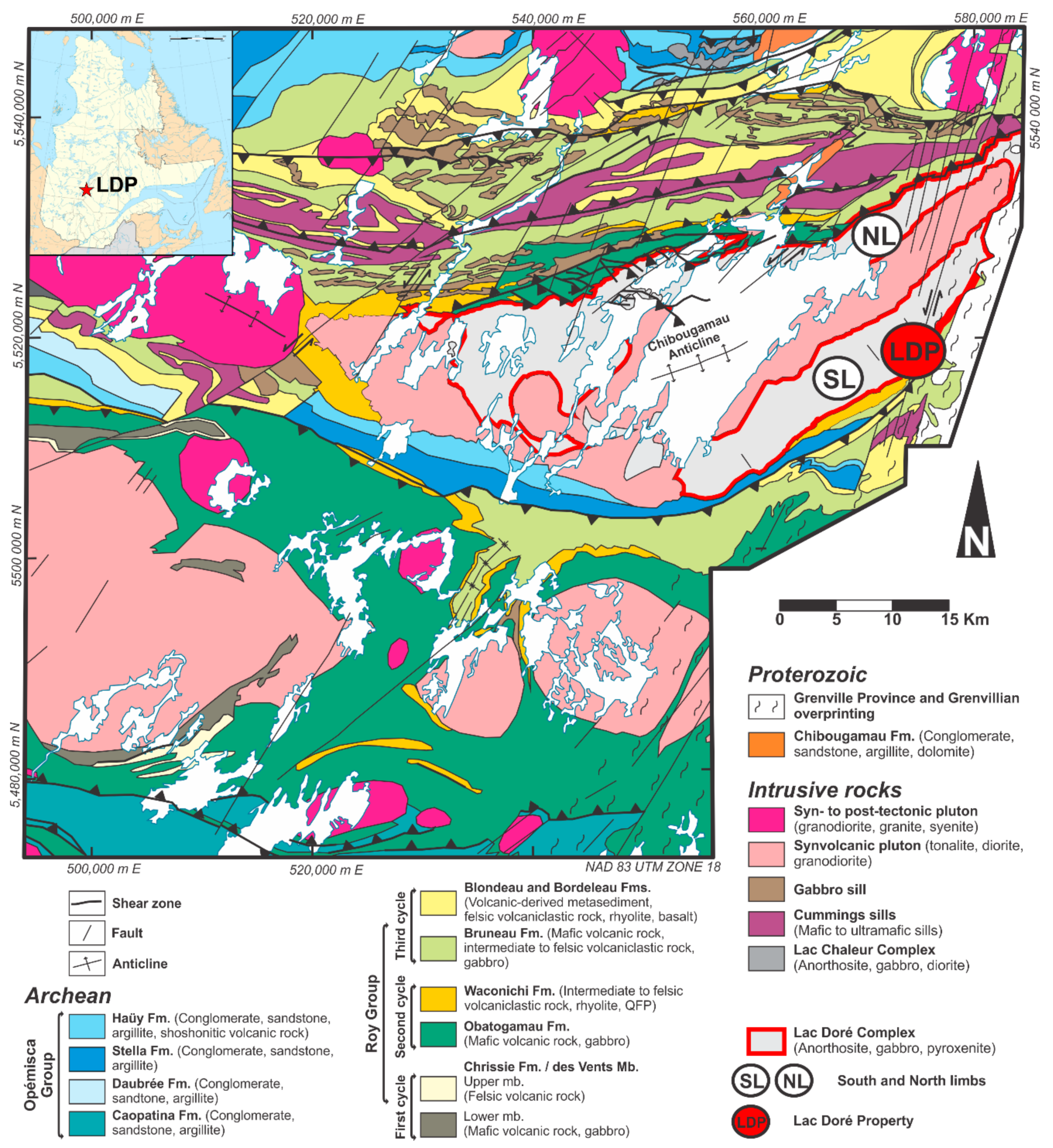
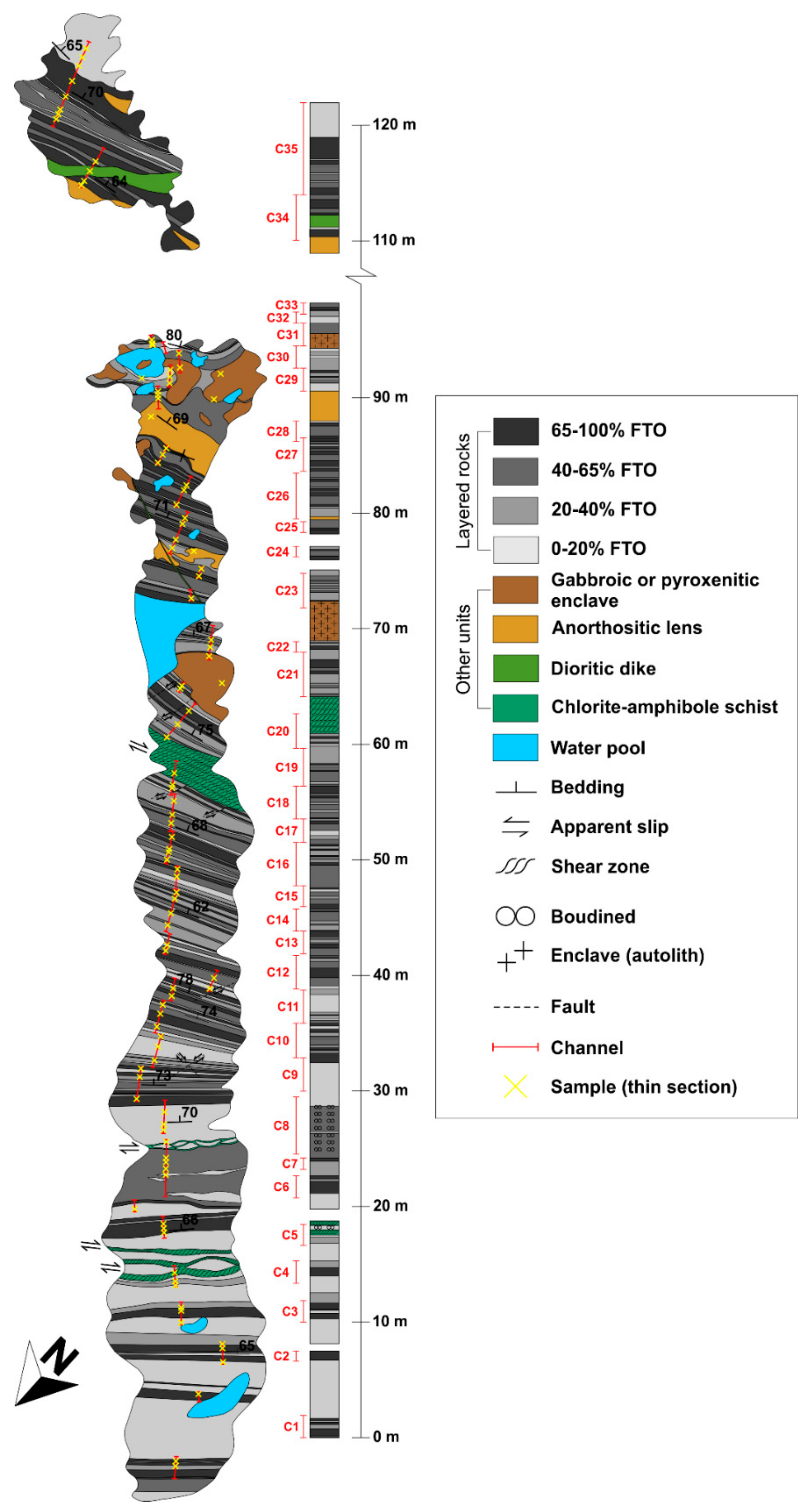
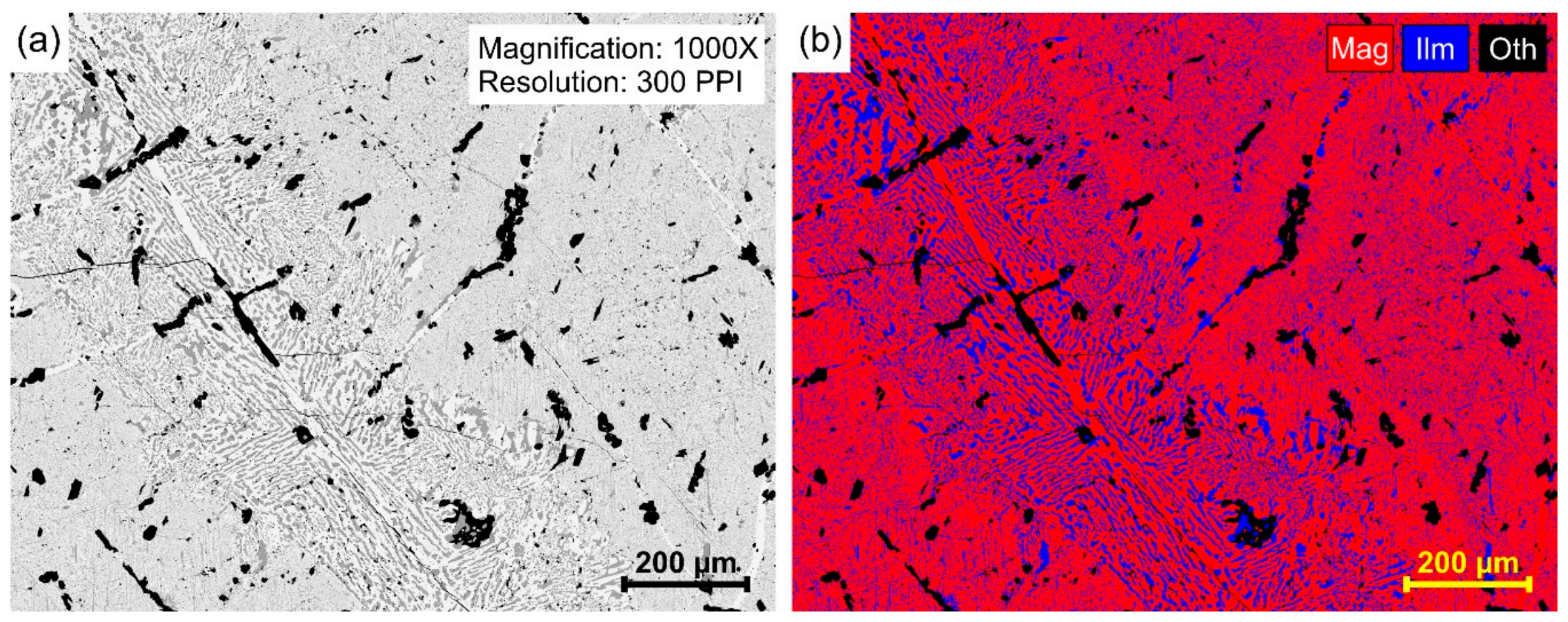
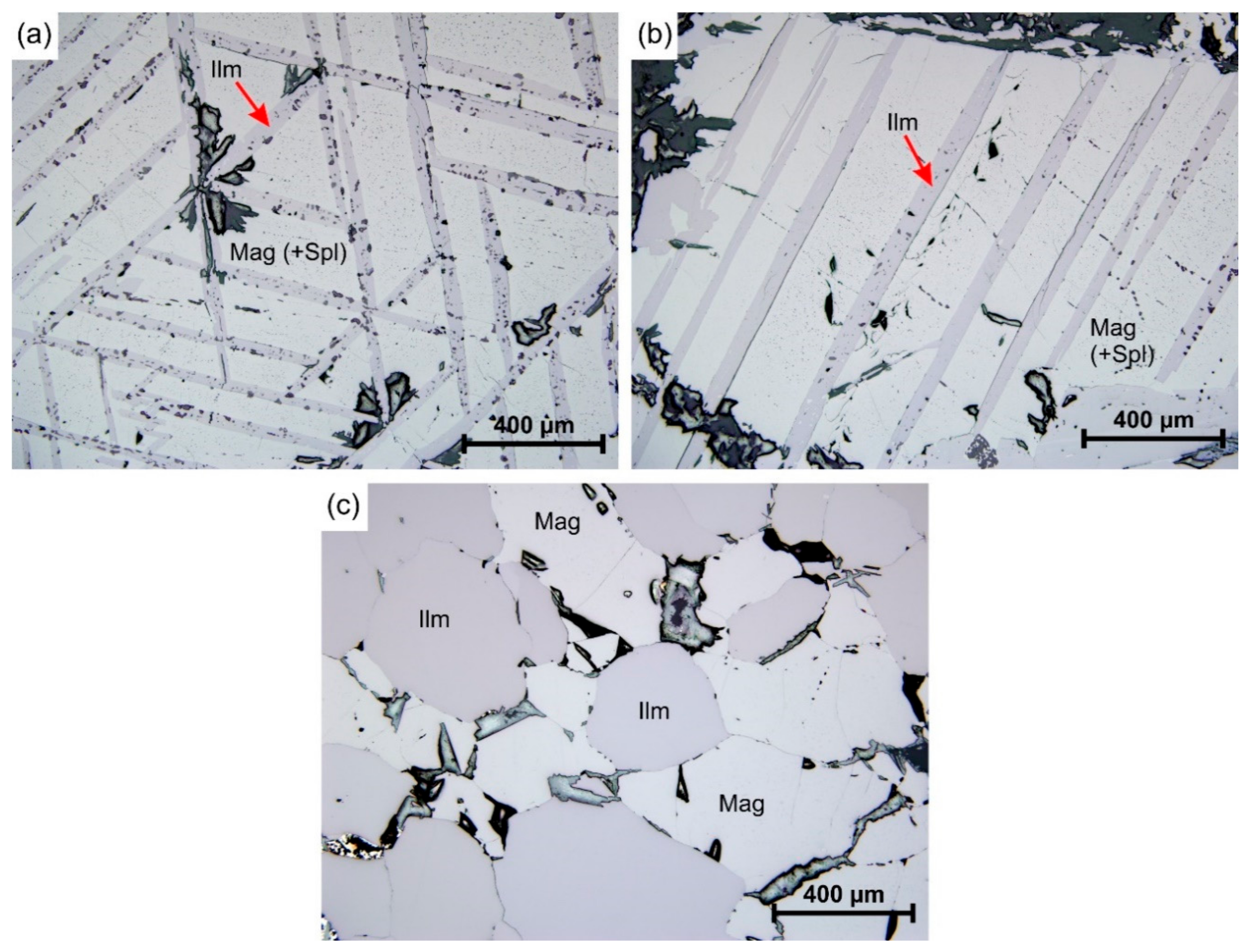
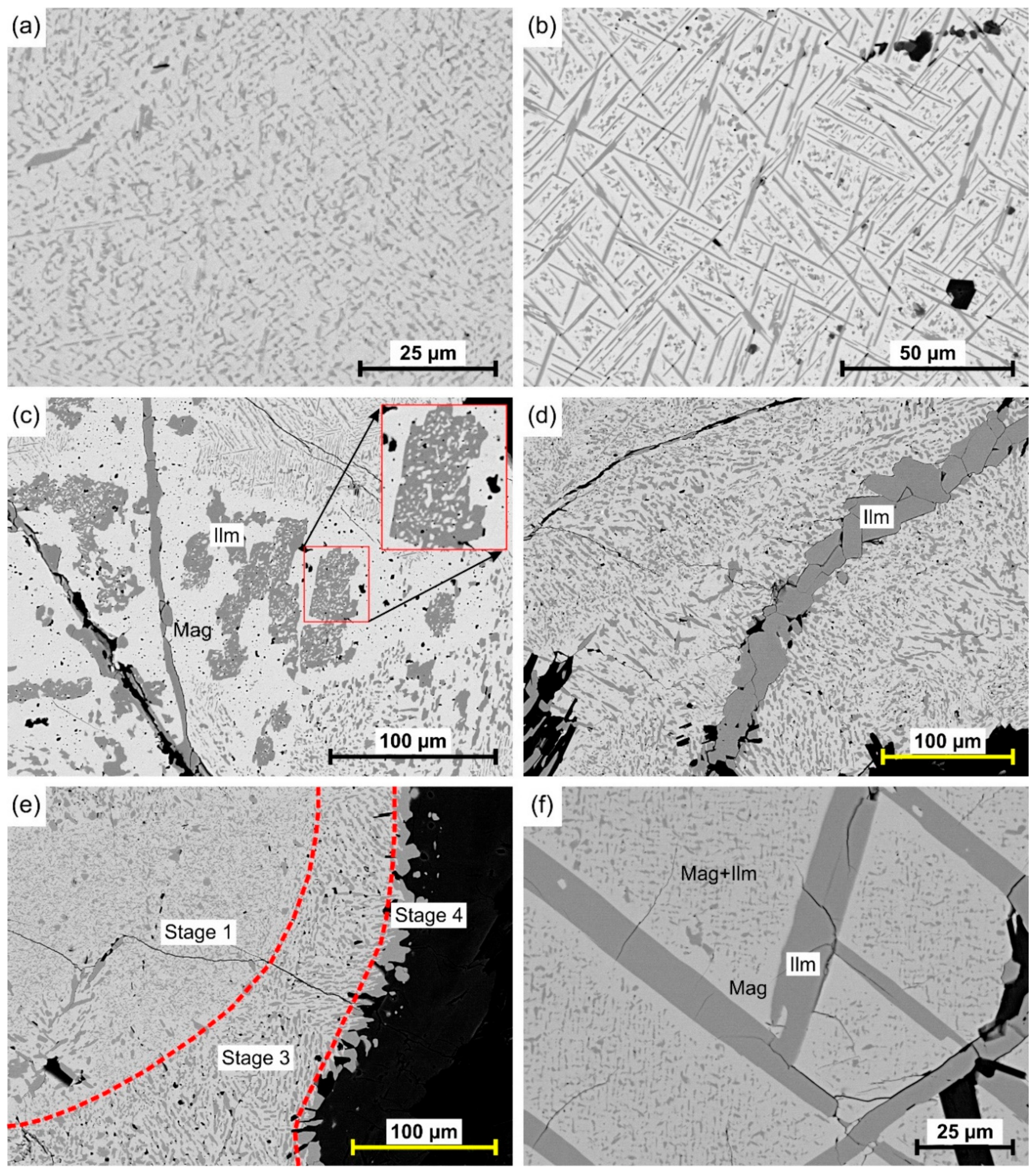
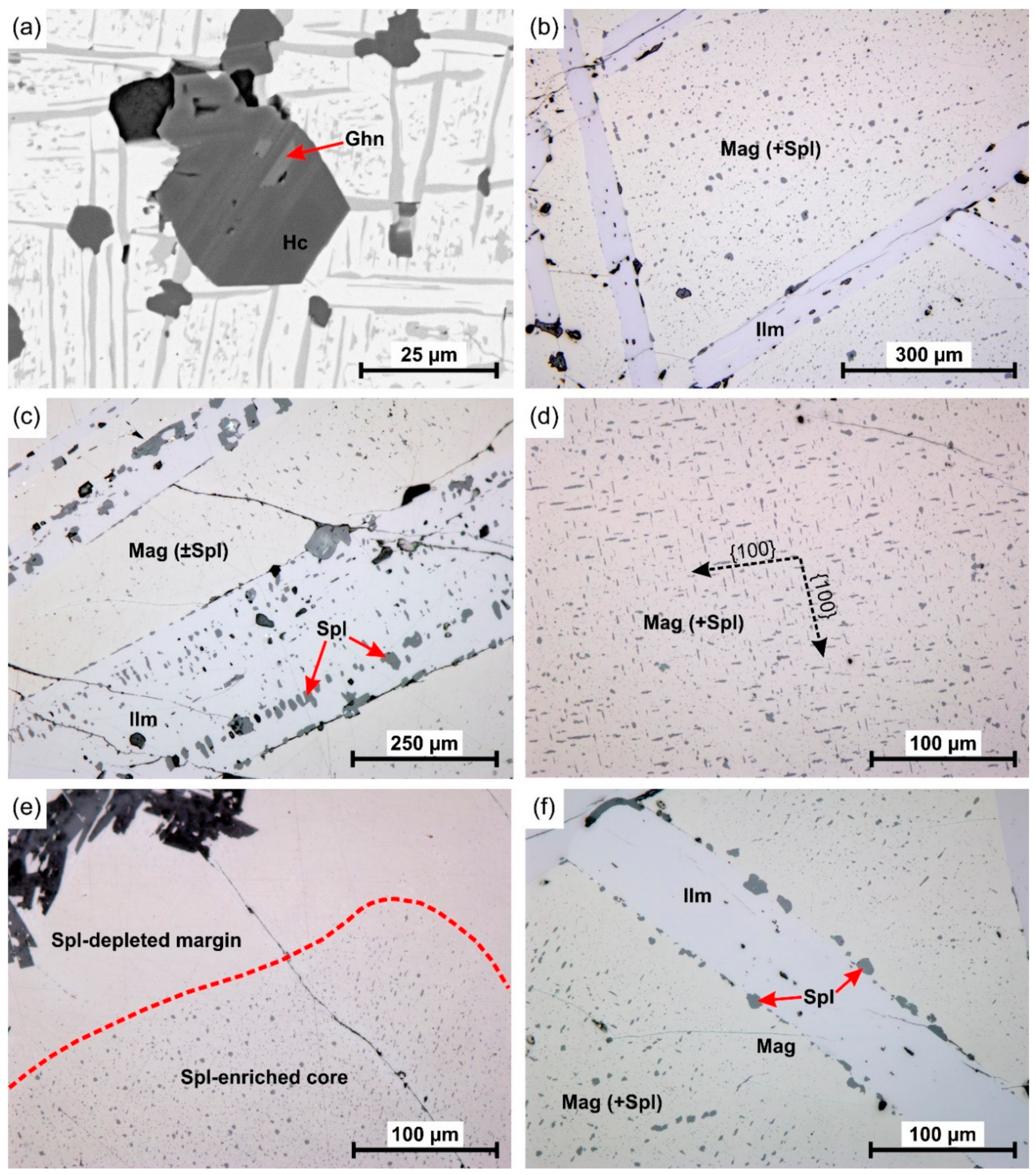
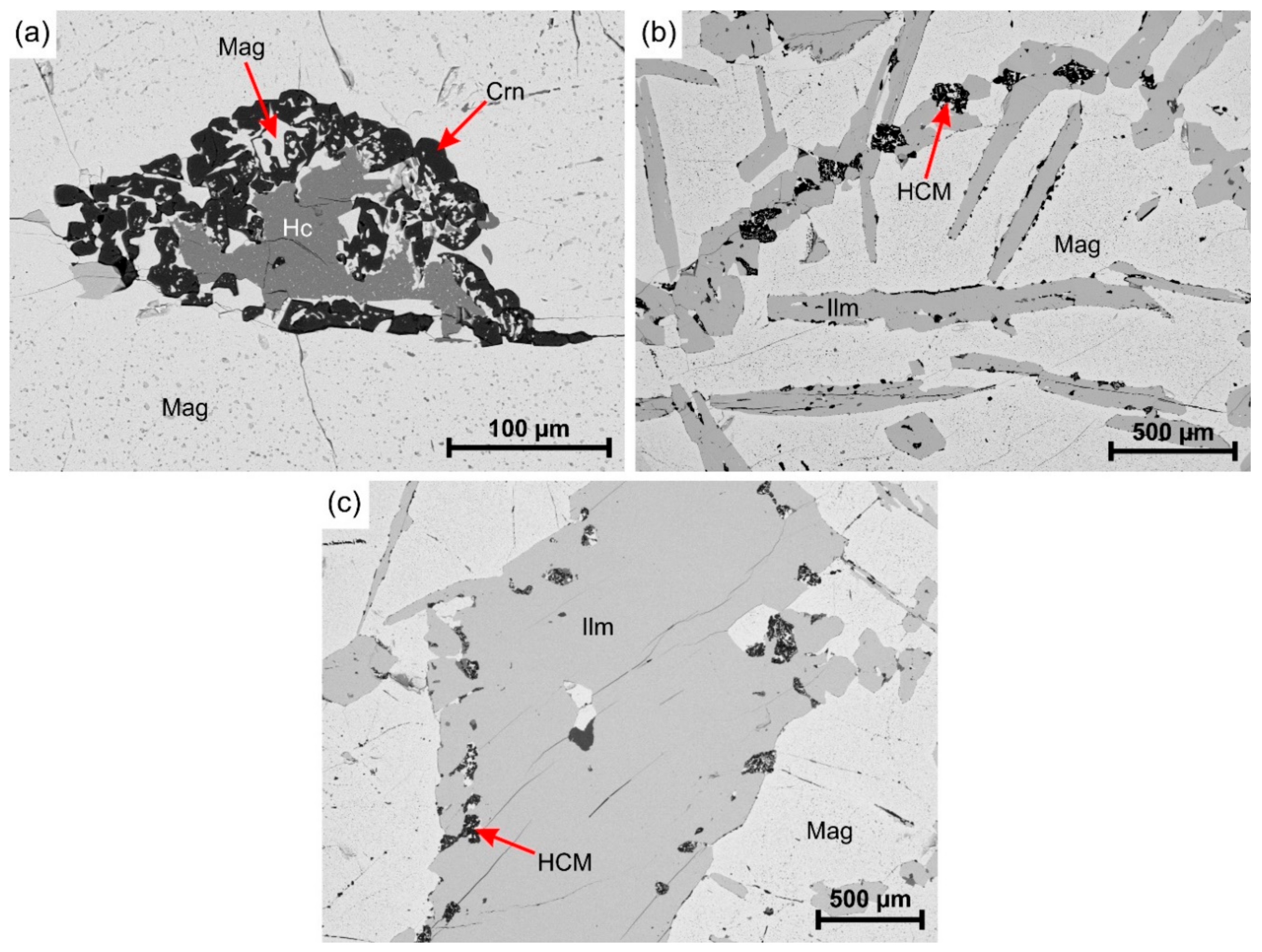
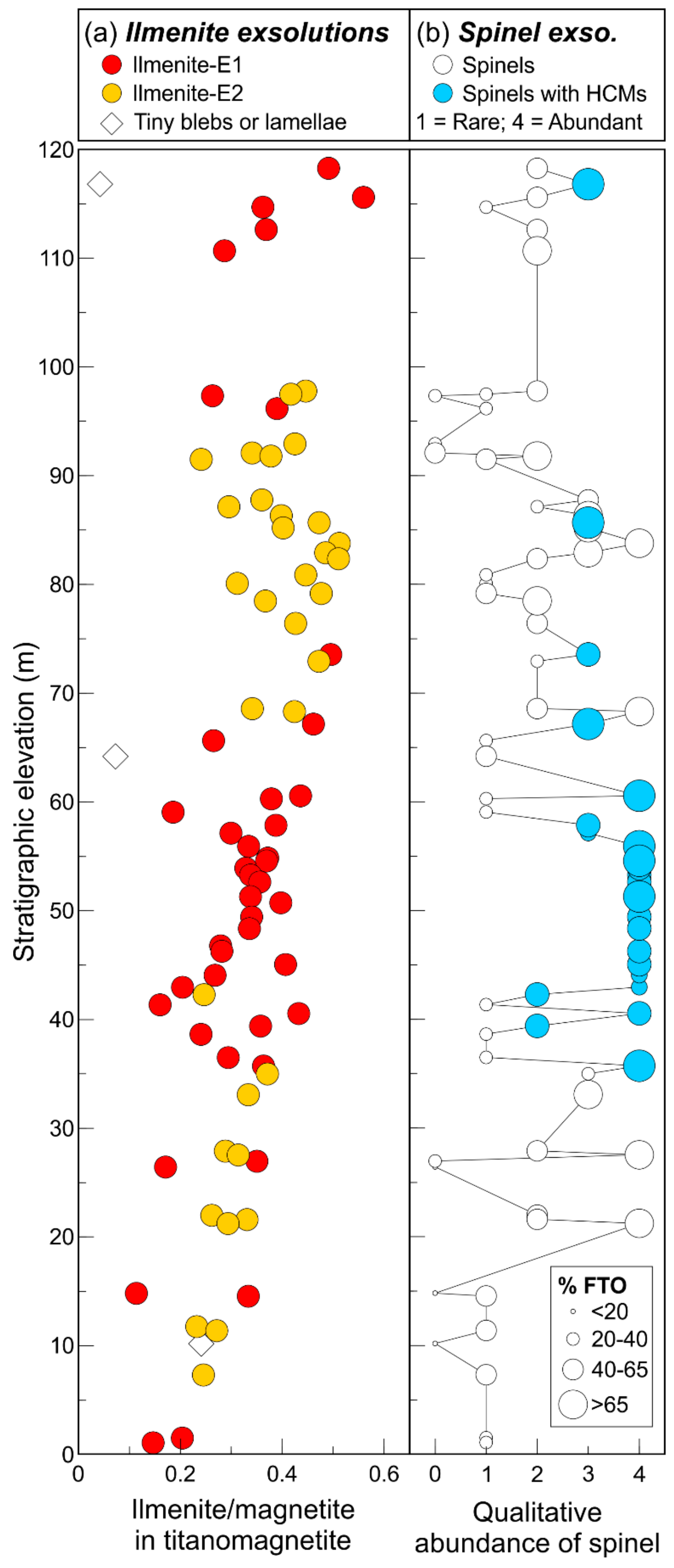

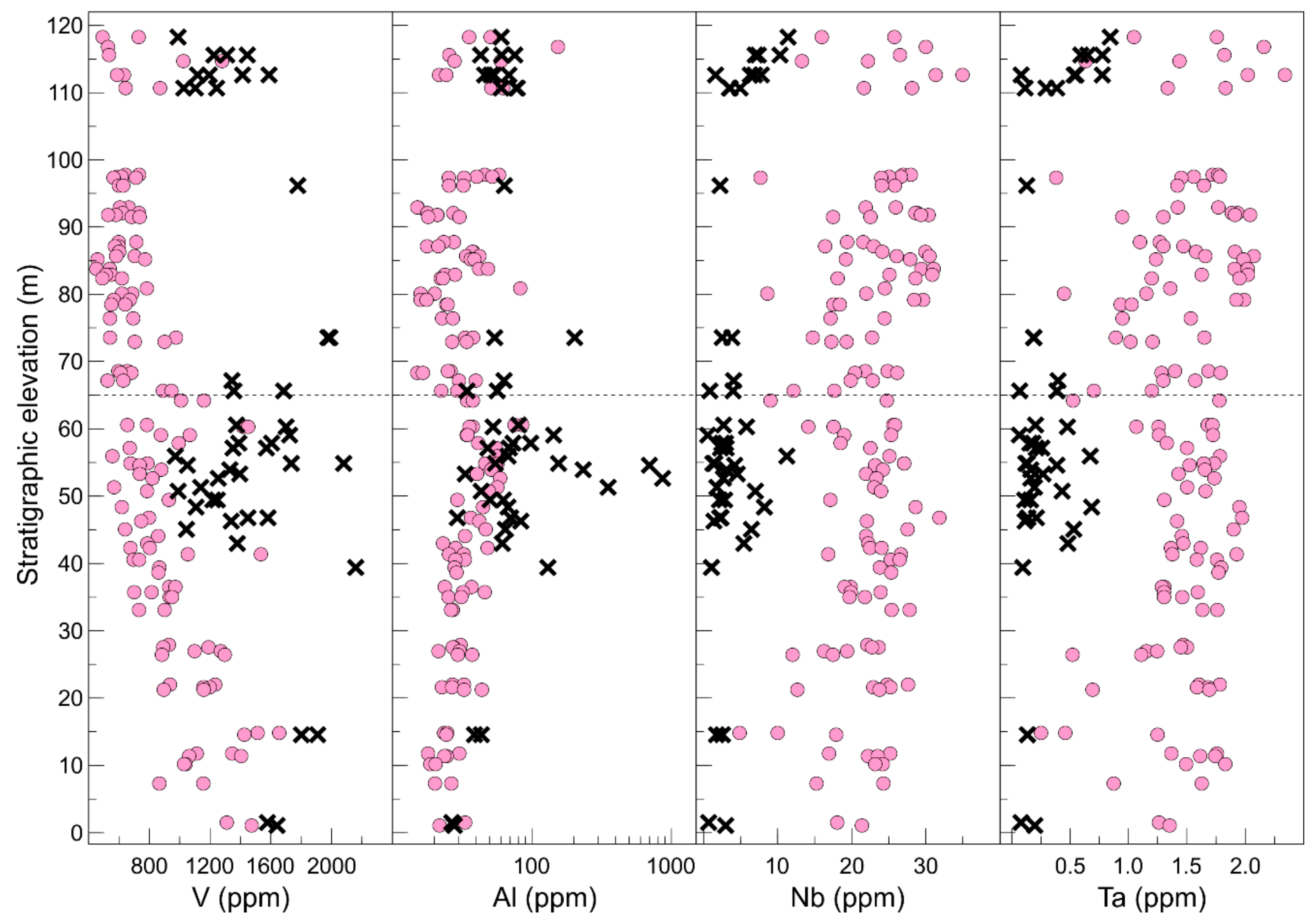
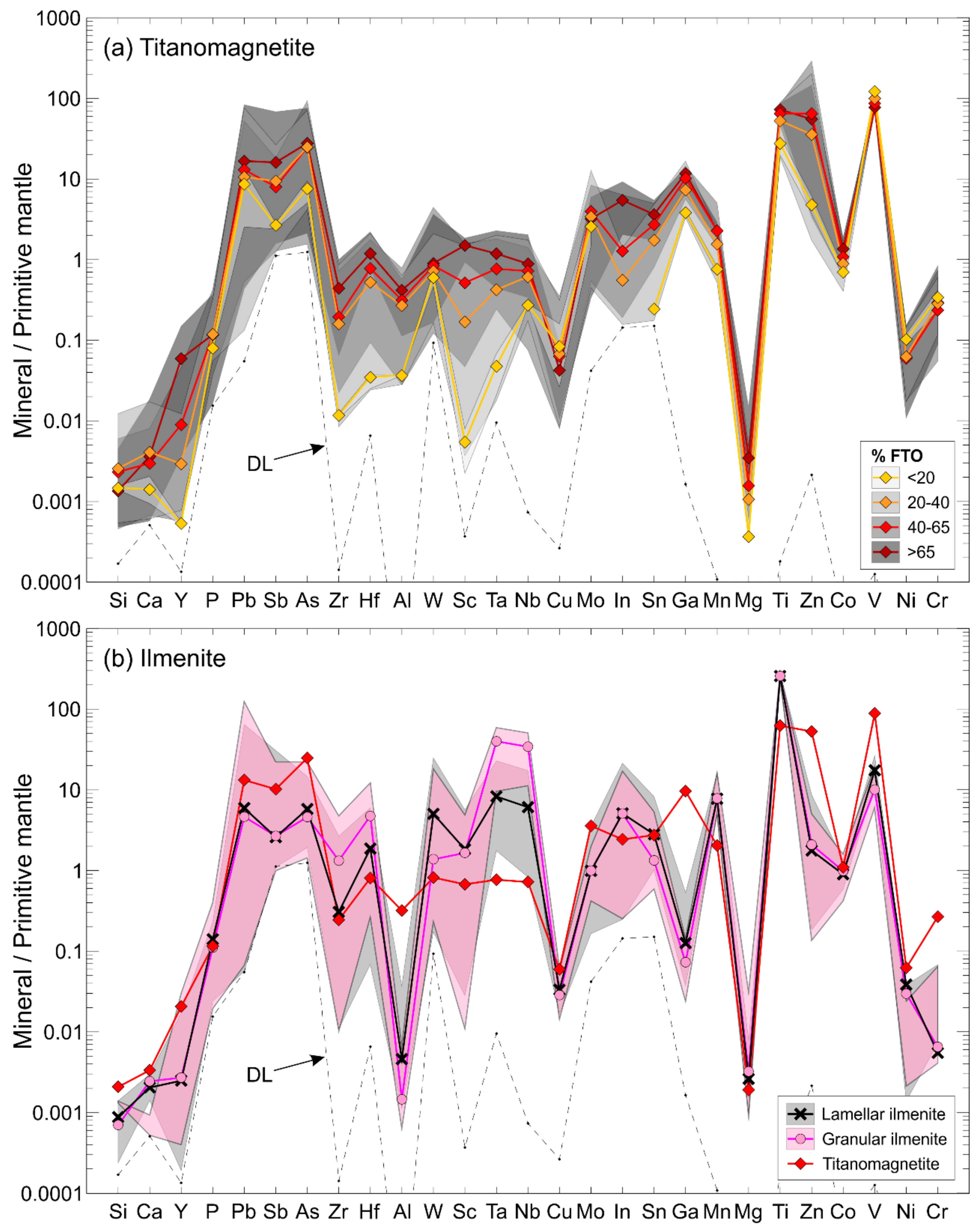


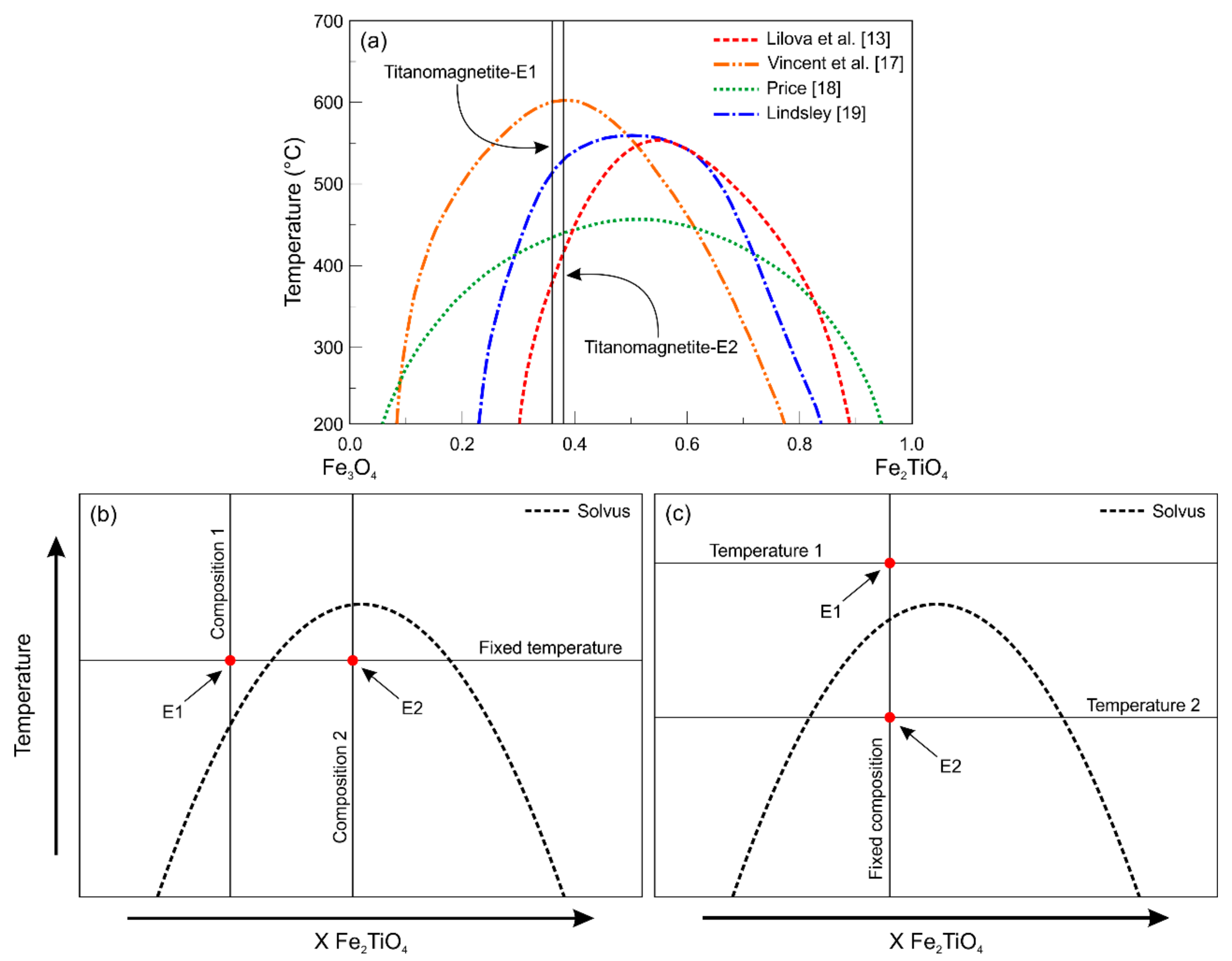
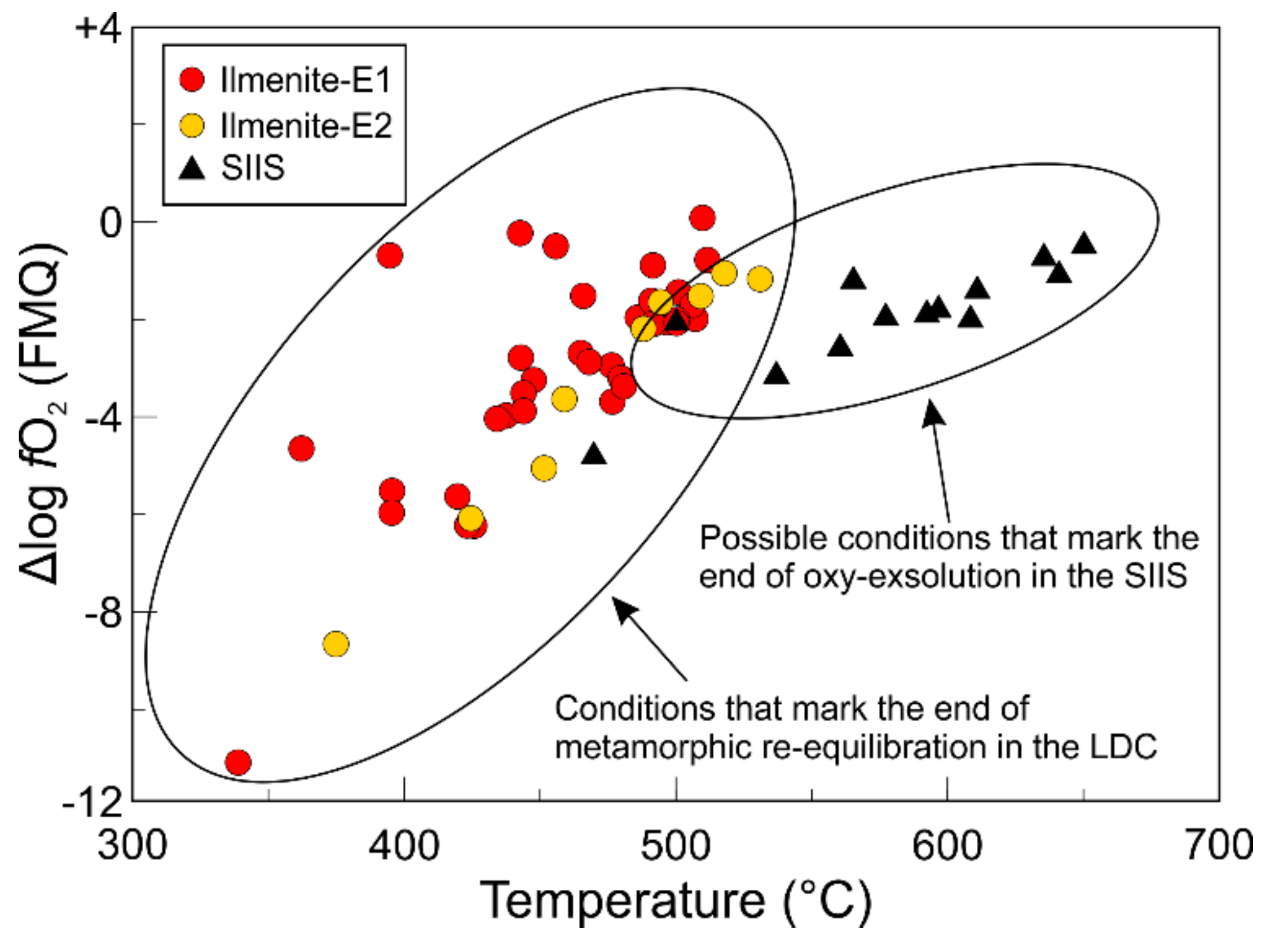
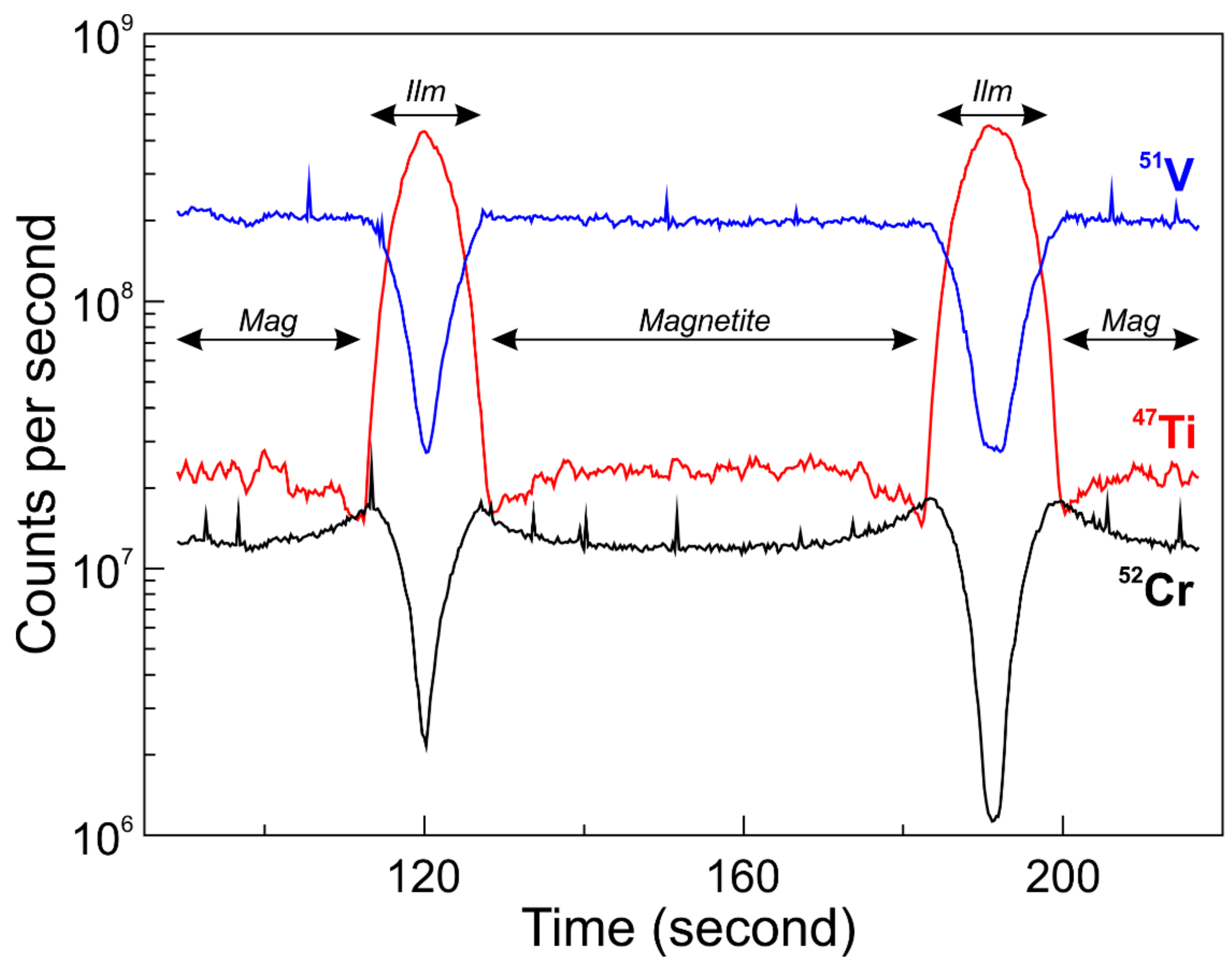
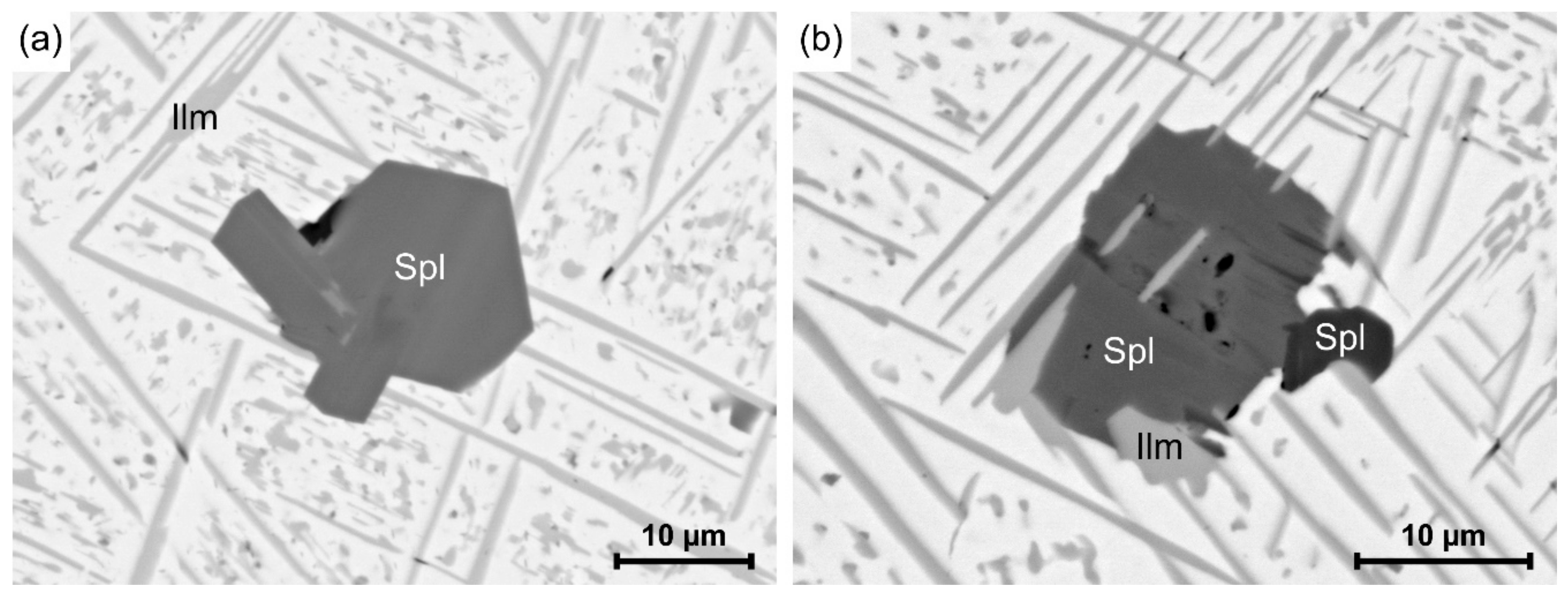
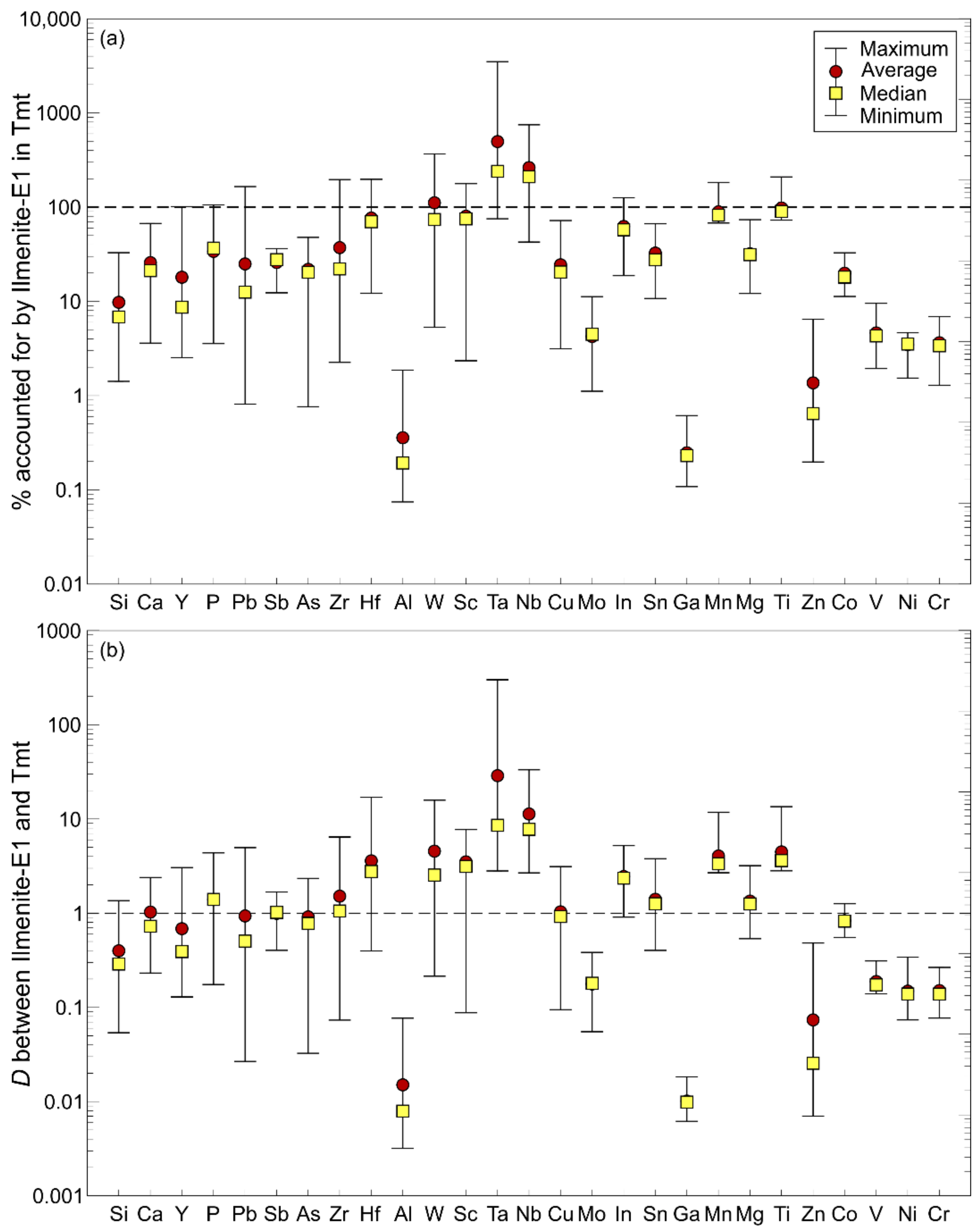
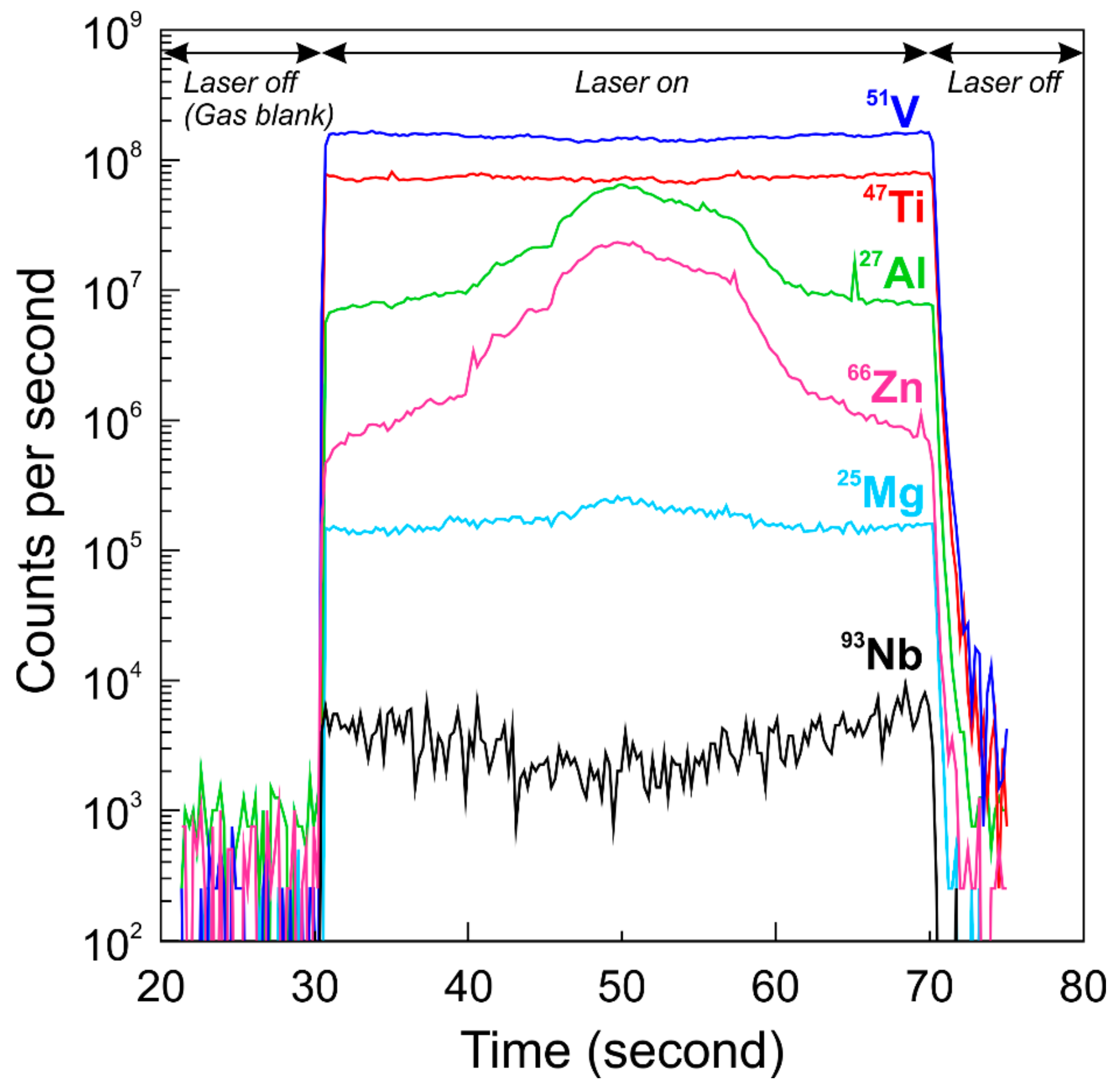
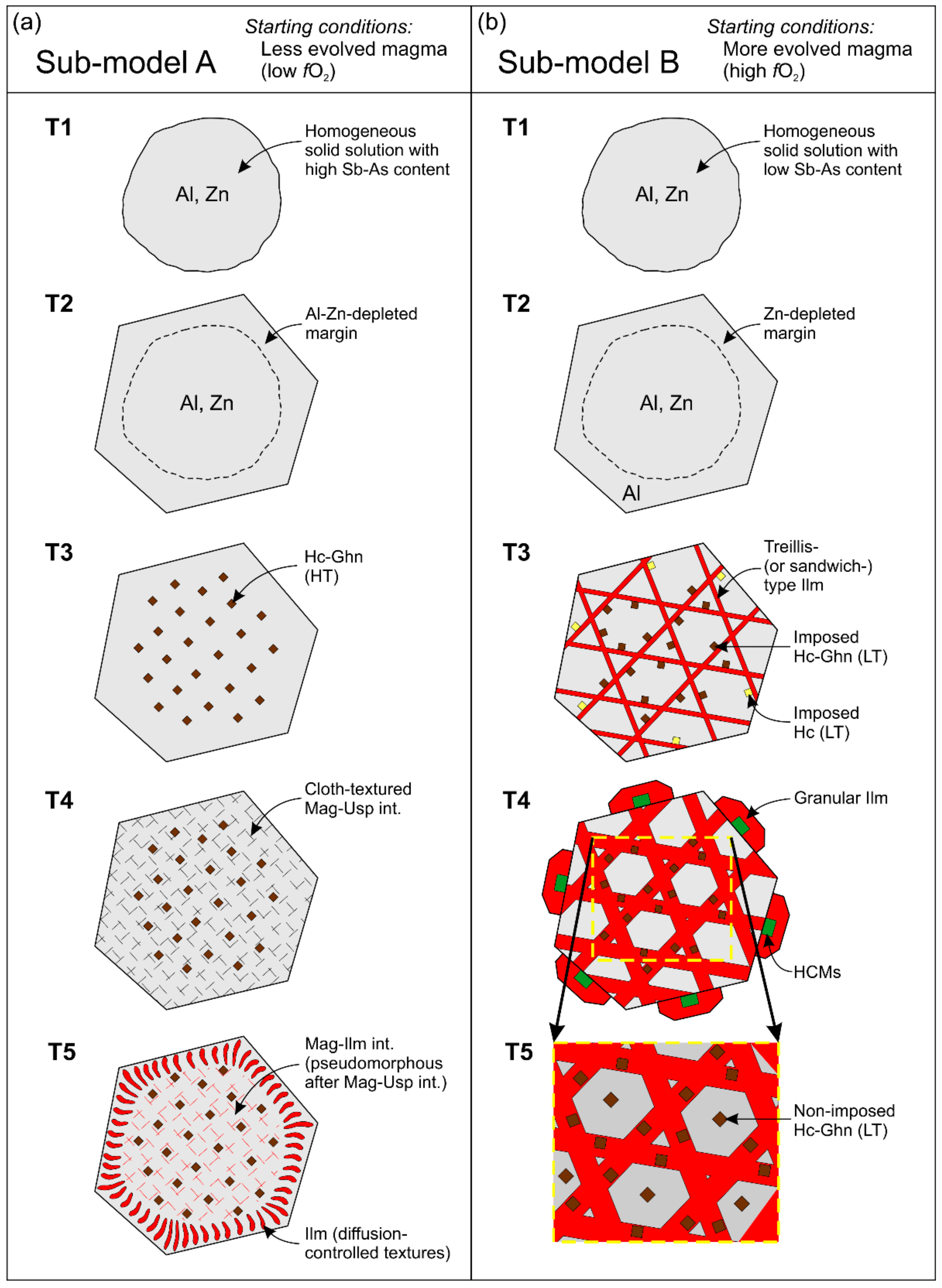
© 2018 by the authors. Licensee MDPI, Basel, Switzerland. This article is an open access article distributed under the terms and conditions of the Creative Commons Attribution (CC BY) license (http://creativecommons.org/licenses/by/4.0/).
Share and Cite
Arguin, J.-P.; Pagé, P.; Barnes, S.-J.; Girard, R.; Duran, C. An Integrated Model for Ilmenite, Al-Spinel, and Corundum Exsolutions in Titanomagnetite from Oxide-Rich Layers of the Lac Doré Complex (Québec, Canada). Minerals 2018, 8, 476. https://doi.org/10.3390/min8110476
Arguin J-P, Pagé P, Barnes S-J, Girard R, Duran C. An Integrated Model for Ilmenite, Al-Spinel, and Corundum Exsolutions in Titanomagnetite from Oxide-Rich Layers of the Lac Doré Complex (Québec, Canada). Minerals. 2018; 8(11):476. https://doi.org/10.3390/min8110476
Chicago/Turabian StyleArguin, Jean-Philippe, Philippe Pagé, Sarah-Jane Barnes, Réjean Girard, and Charley Duran. 2018. "An Integrated Model for Ilmenite, Al-Spinel, and Corundum Exsolutions in Titanomagnetite from Oxide-Rich Layers of the Lac Doré Complex (Québec, Canada)" Minerals 8, no. 11: 476. https://doi.org/10.3390/min8110476
APA StyleArguin, J.-P., Pagé, P., Barnes, S.-J., Girard, R., & Duran, C. (2018). An Integrated Model for Ilmenite, Al-Spinel, and Corundum Exsolutions in Titanomagnetite from Oxide-Rich Layers of the Lac Doré Complex (Québec, Canada). Minerals, 8(11), 476. https://doi.org/10.3390/min8110476




